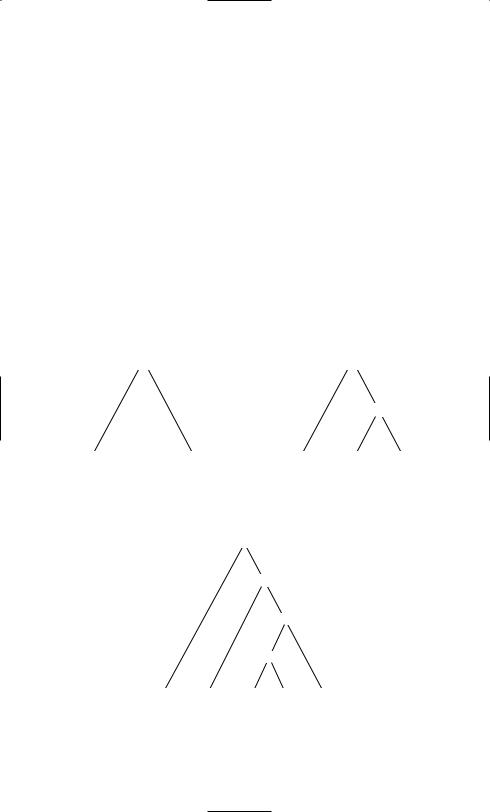
An_Introduction_to_English_Morphology
.pdf
A WORD AND ITS STRUCTURE |
73 |
entirely ‘flat’: that is, that they each consist of merely a string of affixes plus a root, no portions of the string being grouped together as a substring or smaller constituent within the word. An unfortunate consequence of that analysis is that it would complicate considerably what needs to be said about the behaviour of the suffixes -ful and -less. In Chapter 5 these were straightforwardly treated as suffixes that attach to nouns to form adjectives. However, if the nouns unhelpfulness and helplessness are flat-structured, we must also allow -ful and -less to appear internally in a string that constitutes a noun – but not just anywhere in such a string, because (for example) the imaginary nouns *sadlessness and *meanlessingness, though they contain -less, are nevertheless not words, and (one feels) could never be words.
The flat-structure approach misses a crucial observation. Unhelpfulness contains the suffix -ful only by virtue of the fact that it contains (in some sense) the adjective helpful. Likewise, helplessness contains -less by virtue of the fact that it contains helpless. Once that is recognised, the apparent need to make special provision for -ful and -less when they appear inside complex words, rather than as their rightmost element, disappears. In fact, both these words can be seen as built up from the root help by successive processes of affixation (with N, V and A standing for noun, verb and adjective respectively):
(1)help N + -ful → helpfulA un- + helpful → unhelpfulA
unhelpful + -ness → unhelpfulness N
(2)help N + -less → helplessA helpless + -ness → helplessness N
Another way of representing this information is in terms of a branching tree diagram, as in (3) and (4), which also represent the fact that the noun help is formed by conversion from the verb:
(3)
|
|
N |
|
A |
|
|
|
A |
|
N |
|
|
V |
|
un |
help |
ful ness |

74 |
AN INTRODUCTION TO ENGLISH MORPHOLOGY |
(4)
N
A
N
V |
|
|
help |
less |
ness |
(The term ‘tree diagram’ is odd, because the ‘branches’ point downwards, more like roots than branches! However, this topsy-turvy usage has become well established in linguistic discussions.) The points in a tree diagram from which branches sprout are called nodes. The nodes in (3) and (4) are all labelled, to indicate the wordclass of the string (that is, of the part of the whole word) that is dominated by the node in question. For example, the second-to-top node in (3) is labelled ‘A’ to indicate that the string unhelpful that it dominates is an adjective, while the topmost node is labelled ‘N’ because the whole word is a noun. The information about structure contained in tree diagrams such as (3) and (4) can also be conveyed in a labelled bracketing, where one pair of brackets corresponds to each node in the tree: [[un-[[helpV]N-ful]A]A-ness]N,
[[[helpV]N -less]A-ness]N.
One thing stands out about all the nodes in (3) and (4): each has no more than two branches sprouting downwards from it. This reflects the fact that, in English, derivational processes operate by adding no more than one affix to a base – unlike languages where material may be added simultaneously at both ends, constituting what is sometimes called a circumfix. English possesses no uncontroversial examples of circumfixes, and branching within word-structure tree diagrams is never more than binary (i.e. with two branches). (The only plausible candidate for a circumfix in English is the en- …-en combination that forms enliven and embolden from live and bold; but en- and -en each appears on its own too, e.g. in enfeeble and redden, so an alternative analysis as a combination of a prefix and a suffix seems preferable.) The single branch connecting N to V above help in (3) and (4) reflects the fact that the noun help is derived from the verb help by conversion, with no affix.
At (5) and (6) are two more word tree diagrams, incorporating an adverbial (Adv) node and also illustrating both affixal and non-affixal heads, each italicised element being the head of the constituent dominated by the node immediately above it:

A WORD AND ITS STRUCTURE |
75 |
(5)
|
Adv |
|
|
|
A |
|
|
|
A |
|
|
|
V |
|
|
un |
assert |
ive |
ly |
(6) |
|
|
|
|
V |
|
|
|
|
V |
|
|
|
|
V |
|
|
N |
|
re |
de |
class |
ify |
Some complex words contain elements about which one may reasonably argue whether they are complex or not. For example, the word reflection is clearly divisible into a base reflect and a suffix -ion; but does reflect itself consist of one morpheme or two? This kind of uncertainty was discussed in Chapter 2. But, if we put it on one side, then any complex word form consisting of a free root and affixes turns out to be readily analysable in the simple fashion illustrated here, with binary branching and with either the affix or the base as the head. (I say ‘free root’ rather than ‘root’ only because some bound roots are hard to assign to a wordclass: for example, matern- in maternal and maternity.)
Another salient point in all of (3)–(6) is that more than one node in a tree diagram may carry the same wordclass label (N, V, A). At first sight, this may not seem particularly remarkable. However, it has considerable implications for the size of the class of all possible words in English. Linguists are fond of pointing out that there is no such thing as the longest sentence of English (or of any language), because any candidate for longest-sentence status can be lengthened by embedding it in a context such as Sharon says that ___ . One cannot so easily demonstrate that there is no such thing as the longest word in English; but it is not necessary to do so in order to demonstrate the versatility and vigour of English word-formation processes. Given that we can find nouns inside

76 |
AN INTRODUCTION TO ENGLISH MORPHOLOGY |
nouns, verbs inside verbs, and so on, it is hardly surprising that (as was shown in Chapter 2) the vocabulary of English, or of any individual speaker, is not a closed, finite list. The issue of how new words can be formed will be taken up again in Chapter 8.
7.4 More elaborate word forms: compounds within compounds
In the previous section, we saw that the structure of words derived by affixation can be represented in tree diagrams where each branch has at most two branches. The same applies to compounds: any compound has just two immediate constituents. In Chapter 6, all the compounds that were discussed contained just two parts. This was not an accident or an arbitrary restriction. To see this, consider for example the noun that one might use to denote a new cleaning product equally suitable for ovens and windows. Parallel to the secondary compound hair restorer are the two two-part compounds oven cleaner and window cleaner. Can we then refer to the new product with a three-part compound such as window oven cleaner ? The answer is surely no. Window oven cleaner is not naturally interpreted to mean something that cleans both windows and ovens; rather, it means something that cleans window ovens (that is, ovens that have a see-through panel in the door). This is a clue that its structure is not as in (7) but as in (8):
(7)
N
N N N window oven cleaner
(8)
N
N
N N N window oven cleaner

A WORD AND ITS STRUCTURE |
77 |
The structure at (8) seems appropriate even for complex compounds such as verb–noun contrasts and Reagan–Gorbachev encounters. As simple compounds, verb–noun and Regan–Gorbachev certainly sound odd. Nevertheless verb–noun contrasts denotes crucially contrasts between verbs and nouns, not contrasts some of which involve verbs and others of which involve nouns; therefore verb–noun deserves to be treated as a subunit within the whole compound verb–noun contrast. Likewise, a Reagan– Gorbachev encounter necessarily involves both Reagan and Gorbachev, not just one of the two, so Reagan–Gorbachev deserves to be treated as a subunit within Reagan–Gorbachev encounters.
In Chapter 6 we concentrated on compounds with only two members. But, given that a compound is a word and that compounds contain words, it makes sense that, in some compounds, one or both of the components should itself be a compound – and (8), with its most natural interpretation, shows that this is indeed possible, at least with compound nouns. Moreover, the compound at (8) can itself be an element in a larger compound, such as the one at (9) meaning ‘marketing of a product for cleaning window ovens’:
(9)
N
N
N
N |
N |
N |
N |
window |
oven |
cleaner |
marketing |
At this point, it is worth pausing to consider whether these more elaborate examples comply with what was said in Section 6.1 about where stress is placed within compound nouns. Window oven, if it is a compound, should have its main stress on the lefthand element, namely window – and that seems correct. The same applies to window oven cleaner: its main stress should be on window oven, and specifically on its lefthand element, namely window. Again, that seems correct. So we will predict that the whole compound at (9) should have its main stress on the lefthand element too – a prediction that is again consistent with how I, as a native speaker, find it most natural to pronounce this complex word. It

78 |
AN INTRODUCTION TO ENGLISH MORPHOLOGY |
is true that other elements than window can be emphasised for the sake of contrast: for example, I can envisage a context at a conference of sales executives where one might say We are concerned with window oven cleaner márketing today, not with manufácture. Nevertheless, where no contrast is implied or stated (such as between marketing and manufacture), the most natural way of pronouncing the example at (9) renders window the most prominent element.
Can we then conclude that all complex compound nouns follow the left-stressed pattern of simple compound nouns? Before saying yes, we need to make sure that we have examined all relevant varieties. It may have struck you that, in (8) and (9), the compounds-within-compounds are uniformly on the left. We have not yet looked at compounds (or potential compounds) in which it is the righthand element (in fact, the head) that is a compound. Consider the following examples:
(10) |
(11) |
N |
N |
N
N |
N |
N |
N |
N |
holiday |
trip |
holiday |
car |
trip |
(12)
|
|
N |
|
|
|
|
N |
|
|
|
|
|
N |
|
|
|
|
N |
|
N |
N |
N |
N |
N |
holiday |
car |
sight |
seeing |
trip |

A WORD AND ITS STRUCTURE |
79 |
Native speakers are likely to agree sith me that, whereas in (10) the main stress is on holiday, in (11) it is on car. (Again, we are assuming that no contrast is implied – between a holiday trip and a business trip, say.) This is consistent with car trip being a compound with car as its lefthand element, but not (at first sight) with an analysis in which holiday car trip is a compound noun with holiday as its lefthand element. The stress on the righthand element in holiday car trip makes it resemble phrases such as green hóuse and toy fáctory, discussed in Section 6.1, rather than compounds such as gréenhouse and tóy factory. Yet it would be strange if a compound noun cannot itself be the head of a compound noun, given that any other kind of noun can be.
The best solution seems to be to qualify what was said in Chapter 6 about stress in compound nouns. The usual pattern, with stress on the left, is overridden if the head is a compound. In that case, stress is on the right – that is, on the compound which constitutes the head. Another way of expressing this is to say that the righthand component in a compound noun gets stressed if and only if it is itself a compound; otherwise, the lefthand component gets stressed. This is consistent with the examples in Chapter 6 as well as with native speakers’ intuitions about pairs such as (10) and (11). It is also consistent with a more complex example such as (12), involving internal compounds on both left and right branches. If you apply carefully to (12) the formula that we have arrived at, you should find that it predicts that the main stress should be on sight – which seems correct.
7.5 Apparent mismatches between meaning and structure
Earlier, the point was made that the reliable interpretation of complex words (whether derived or compounded) depends on an expectation that meaning should go hand in hand with structure. So far, this expectation has been fulfilled (provided we ignore words with totally idiosyncratic meanings). The meaning of a complex whole such as unhelpfulness or holiday car trip is built up out of the meanings of its two constituent parts, which in turn are built up out of the meanings of their parts, and so on until we reach individual morphemes, which by definition are semantically indivisible. In this section, however, we will discuss a few instances where this expectation is not fulfilled. Discussing these instances leads us to the question of whether a unit larger than a word (that is, a phrase) can ever be a constituent of a compound word. There is no agreed answer to these questions, but the kinds of English expression that give rise to them are sufficiently common that they cannot be ignored, even in an introductory textbook.

80 |
AN INTRODUCTION TO ENGLISH MORPHOLOGY |
Consider the expression nuclear physicist. Its structure seems clear: it is a phrase consisting of two words, an adjective nuclear and a noun physicist. So, if the interpretation of linguistic expressions is always guided by their structure, it ought to mean a physicist who is nuclear. Yet that is wrong: a physicist is a person, and it makes no sense to describe a person as ‘nuclear’. Instead, this expression means someone who is an expert in nuclear physics. So we have a paradox: in terms of morphology and syntax, the structure of the expression can be represented by the bracketing [[nuclear] [physicist]], but from the semantic point of view a more appropriate structure seems to be [[nuclear physic-]-ist]. We thus have what has come to be called a bracketing paradox. In this instance, the meaning seems to direct us towards an analysis in which the suffix -ist is attached not to a word or root but to a phrase, nuclear physics. Is it possible, then, for a word to be formed by adding an affix not to another word but to a phrase?
A similar problem is presented by the expression French historian. This has two interpretations: ‘historian who is French’ and ‘expert in French history (not necessarily a French person)’. The first interpretation presents no difficulty: it is the interpretation that we expect if we analyse
French historian as a phrase, just like green house (as opposed to greenhouse). This implies a structure [[French] [historian]]. However, the second interpretation seems to imply a structure [[French histori-]-an], in which a phrase is combined with an affix. We are faced with a dilemma. Should we acknowledge the second structure as the basis for the second interpretation? Or should we say that, with both interpretations, the structure of the expression is the same (namely [[French] [historian]]), but that for one of the interpretations this structure is a bad guide? Without putting forward a ‘right answer’, I will mention two further observations that must be taken into account – two observations that, it must be said, pull in opposite directions.
Examples of other adjective–noun combinations whose meanings diverge from their structure are plastic surgeon (denoting not a kind of doll, but an expert in cosmetic surgery) and chemical engineer (denoting an expert in chemical engineering, not a person who is ‘chemical’). These differ from nuclear physicist, however, in that there is no way of bracketing them so as to yield a structure that corresponds closely to the meaning. So, even if the meaning of nuclear physicist can be handled by the paradoxical bracketing [[nuclear physic-]-ist], no such device is available for plastic surgeon and chemical engineer. This means that some other way of reconciling their structure–meaning divergence must be found. It does not matter for present purposes how that reconciliation is achieved. What does matter is that, however it is achieved, the same method will

A WORD AND ITS STRUCTURE |
81 |
presumably be available to handle nuclear physicist, and also French historian in the sense ‘expert in French history’. This weakens the argument for recognising a ‘semantic’ bracketing distinct from the ‘grammatical’ one. Rather, we can simply say that, for example, [[French] [historian]], so structured, has two interpretations.
Those examples all involve derivation. What about any apparent bracketing paradoxes involving compounding? Consider the item French history teacher. In the sense ‘French teacher of history’, this is a phrase consisting of an adjective and a noun, just like French painter, the only difference being that the noun in French history teacher is the compound history teacher, just like the noun portrait painter in French portrait painter. But what about the interpretation ‘teacher of French history’? Is this a compound noun with the structure [[French history] teacher]? The trouble with that analysis is that French hístory, with its stress on history, seems clearly to be a phrase, not a word; yet, if a phrase such as French history is permitted to appear as a component of a compound word, we are faced with explaining why phrases cannot appear inside compounds generally – why, that is, we do not encounter compounds such as eventful history teacher, with the phrase eventful history as its first element, and with the meaninging ‘teacher of eventful history’, or history skilled teacher, with the phrase skilled teacher as its head. Perhaps, then, we should say of French history teacher essentially the same as what was suggested concerning French historian: it has only one structure, that of a phrase ([French [history teacher]]), even though it has two interpretations, one of which diverges from that structure.
Some implications of that analysis are unwelcome, however. Consider the expressions fresh áir fanatic and open dóor policy. Their main stress is on air and door, as indicated, and their meanings are ‘fanatic for fresh air’ and ‘policy of maintaining an open door (to immigration, for example)’. These are parallel to the meaning ‘teacher of French history’, which, we have suggested, diverges from its structure [French [history teacher]]. But, whereas French history teacher has a second meaning that corresponds exactly to that structure, fresh áir fanatic and open dóor policy have no such second meaning; one cannot interpret them as meaning ‘fresh fanatic for air’ or ‘open policy about doors’. So a bracketing such as [fresh [air fanatic]] would diverge not just from one of the meanings of fresh air fanatic, but from its only meaning!
A clue to a way out of this problem lies in comparing the actual expressions at (13) with the non-existent or ill-formed ones in (14):
(13)a. fresh air fanatic b. open door policy

82AN INTRODUCTION TO ENGLISH MORPHOLOGY
c.French historian ‘expert in French history’
d.nuclear physicist
e.sexually transmitted disease clinic
(14)a. cool air fanatic ‘fanatic for cool air’
b.wooden door policy ‘policy on wooden doors’
c.suburban historian ‘expert on the history of suburbs’
d.recent physicist ‘expert on recent physics’ (not ‘recent expert on physics’)
e.easily transmitted disease clinic
The phrases fresh air and cool air differ in that fresh air is a cliché, even if not precisely an idiom; that is, fresh air recurs in a number of stock expressions such as get/need some fresh air and get out into the fresh air, whereas there are no such stock expressions containing cool air. Similarly, French history is a cliché in that the history of France is a recognised specialism among historians; on the other hand, the history of suburbs is not recognised as a specialism to the same degree, so the phrase suburban history, though perfectly easy to interpret, is not a cliché. The same goes for open door versus wooden door, nuclear physics versus recent physics, and sexually transmitted disease versus easily transmitted disease ; the first expression in each pair is an idiom or cliché, while the second is not. What we need to say, it seems, is that a phrase can form part of a compound or derived word provided that the phrase is lexicalised or in some degree institutionalised, so as to become a cliché.
From the point of view of the distinction carefully drawn in Chapter 2 between lexical items and words, this is a surprising conclusion. On the basis of the facts examined in Chapter 2, it seemed that there was no firm link between lexical listing and grammatical structure. Now it appears that that view must be qualified: lexically listed phrases (i.e. idioms) or institutionalised ones (i.e. clichés) can appear in some contexts where unlisted phrases cannot. Whether we should analyse these contexts as being at the word level, so as to treat nuclear physicist and fresh air fanatic as words rather than phrases, is an issue that beginning students of wordstructure should be aware of but need not have an opinion about.
7.6 Conclusion: structure as guide but not straitjacket
It is not surprising that the structure of complex words should guide us in their interpretation. What is perhaps surprising is the uniformity of this structure in English: no node ever has more than two branches, and the element on the righthand branch (whether a root, an affix or a word) is usually the head. What is more, the freedom with which complex
